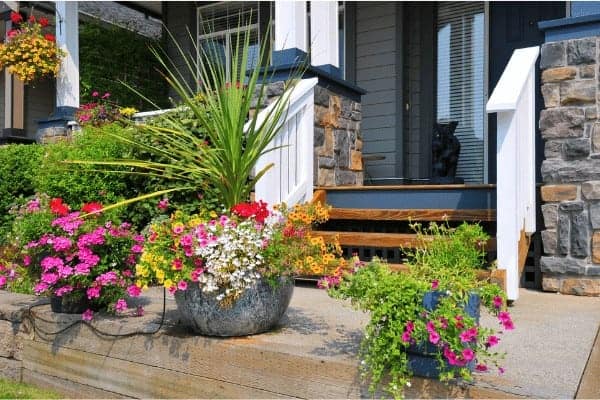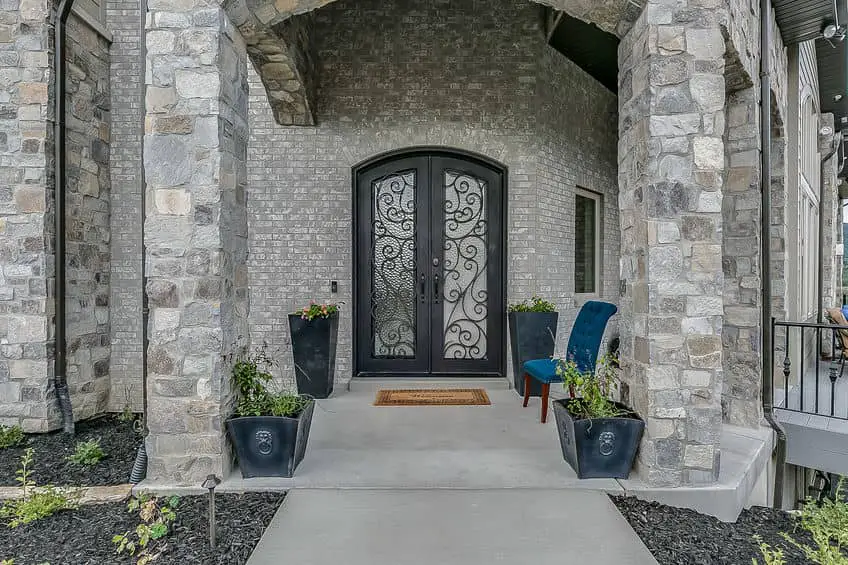Boosting curb appeal is a worthy goal of any garden design project. A tasteful arrangement of plants can create a welcoming experience for both you and your guests upon arrival.
But the value of your property’s appearance from the street does not end there. Since curb appeal contributes to the first impression people have when seeing your home, it can play a crucial role in increasing property value.
Incorporating container plants into your landscape is an ideal way to enhance the aesthetics of your front yard. In this article, we’ll tell you all you need to know about how to design a container garden to create curb appeal.
Let’s dive right in.

Developing container garden design ideas
Your first task in designing a container garden that will increase curb appeal is to develop an overall vision for your project. From the beginning, you should have an idea of the general effect you want to create using your container plants. This vision can change through the planning process. But having a clear initial vision remains essential in ensuring your project is a success. (New to container gardening? Check out our Container Gardening for Beginners [Quick Start Guide].)
There are several important questions that you will need to ask yourself so that you can develop your design intent. The first question is, where do you want to place your container garden?
Choosing a location for your container garden

The location of your container garden is critical. Location influences what plants will survive in your container garden as well as the overall appearance of your landscape. To create curb appeal, you should place container gardens in locations where they will accent important landscape features. If you are struggling to generate location ideas on your own, here are a few great places for a container garden:
- On front steps
- Along walkways
- On top of garden walls
- Near mailboxes or signposts
- In existing garden beds
A burst of attractive flowers or foliage in any of those locations can aid in creating curb appeal. Just remember that the exact location of your container garden will depend on the unique features of your home. Try placing container gardens near areas of frequent use, such as the main entrance to your house.
You should consider the ease of maintenance as well. Make sure to put your container garden in an area you can access easily for regular pruning and watering. Easy access will allow you to care for your container garden so that it remains healthy and beautiful season after season.
Picking the right plants for your container garden
Now that you have a location for your container garden, you can begin to consider the plants you want to grow. From the broadest perspective, there are three primary varieties of plants from which you can choose. Those main categories are:
- Annuals
- Perennials
- Woody Plants
Let’s take a look at what each of those plants has to offer for your container garden design.
Planting annuals in containers
Annuals are extremely common in container garden designs. The lifespan of these plants lasts for a single growing season. That means that if you want annuals in your container garden, you will have to replace them every year.
This may sound like a laborious task. But many people find planting annuals to be an enjoyable experience. If you enjoy a more hands-on approach to gardening, annuals may be the right plant for your container garden. These plants have a manageable size and often feature vibrant flowers in a multitude of shades.
Planting perennials in containers
Unlike annuals, perennials will return every year. Each growing season, the leaves, stems, and flowers of a perennial plant emerge from the soil. When winter arrives, these above-ground parts of the plant will whither and die. However, the root system remains alive throughout winter.
Since the root system survives the winter, it can send forth the same growth in the following growing season. This eliminates the need to continually replace the plants in your container garden. There is a wide variety of perennial plants available to you. Each of these can come with intriguing leaves or flowers that are attractive to humans and pollinators alike.
Planting woody plants in containers
Compared to annuals and perennials, it is less common to see woody plants in container gardens. Simply put, woody plants are the plants whose old growth takes the form of wood. Nearly all trees and shrubs are woody plants.
Woody plants continue to expand above and below the surface of the soil. This can present some limitations for using woody plants in container gardens. The most common issue is that the root system will run out of room once it meets the hard edge of the container. The remedy for this is to occasionally transplant your woody plants to a new container when the time is right.
Stylistic considerations for increasing curb appeal
Now that you have an understanding of annuals, perennials, and woody plants, it is time to make some stylistic choices. Designing a container garden to increase curb appeal is all about creating a pleasing visual experience. As such, your design choices should relate to your personal stylistic preferences.

At this stage, think less about specific plant species and more about the general look you want to create. Think about color, texture, and size as you imagine your container garden design. Here are a few style options to give you some inspiration:
- Flower garden: A container garden filled with your favorite blooms
- Foliage garden: A garden in which the main focus in the shape, size, and texture of plant leaves
- Herb garden: A container housing common kitchen herbs for your use
- Evergreen garden: A garden featuring the year-round appeal of evergreen plants
- Dwarf/Bonsai garden: A garden of dwarf species small enough to thrive in a container
Deciding your style is one of the more enjoyable aspects of designing any garden. But once that stage is complete, it is time to confront one of the main limitations for your container garden design.
Understanding growing requirements of your plants
Regardless of your vision, the success of your container garden design depends on the specific growing requirements of the plants you choose. Some plants will not survive in your yard despite your greatest efforts to maintain them.

After establishing your style preferences, you need to find plants that fit your aesthetic and can thrive in the location you chose for your container garden. There are several requirements you need to keep in mind as you look for specific plant species. Here are a few of the most important ones:
- Sun/Shade
- Soil moisture
- Soil acidity
For container gardens, think first about sun and shade. Since containers are not rooted to the ground, you have flexibility in changing your container garden’s location in relation to the sun. Fortunately, container gardens come with some advantages that make meeting growing requirements much easier.
Advantages of using containers for plants to create curb appeal
The most notable benefit of container planting is that you have complete control over the soil in your container garden. Soil characteristics are an essential factor in a plant’s survival. In a typical garden, you will have to work with the soil that is already present.
With a container garden, you can create the perfect soil conditions for the plants you have chosen. You will have the chance to dictate the acidity, moisture, and nutrient level in your container garden.
This control makes it much more likely that your plants will survive and thrive over the years. This is the same reason why so many vegetable gardeners opt for raised beds rather than planting in the ground.
Choosing the right container for your plant
Once you have your location and plants chosen, it is time for one last major decision – choosing the container itself. Before wrapping up this article, let’s look at some critical features you should think about when browsing container options. In the following sections, you find important information about how the container you choose can dictate the success of your container garden design.
Container size for plants

It is no surprise that the size of your container indicates how many plants you can include in your container garden. Smaller containers are great for annual planting schemes, while larger ones are better for woody shrubs.
Remember that you don’t necessarily need to fit all your plants in one container. Instead, it is often more appealing to create a series of container gardens arranged throughout your front yard landscape.
Container garden drainage
Your container needs to allow for drainage. Without a way for water to escape from the bottom of the container, your plants may decline due to the excessive moisture. To help prevent overwatering, fabric grow bags are a great option.
Choosing a container style for curb appeal

As you shop, you’ll find that there are many container styles. The appearance of your container is up to you, but try to find containers that have an exterior appearance that complements the style of your house. The shapes and materials of the container will play a major role in achieving that aesthetic goal.
Final Thoughts on Designing a Container Garden to Increase Curb Appeal
Container gardens offer significant advantages to home gardeners. But to reap those benefits, you need to design and plan your container garden with care. This approach to planting gives you complete control over the quality of your soil and the arrangement of your container plants throughout your yard. Along with these benefits, a well-designed container garden can also improve the curb appeal of your home.

John Haryasz is a freelance writer and landscape designer. In the field of landscape architecture, he has contributed to many successful design projects throughout the country. As a writer, John specializes in creating captivating and informative web content. Through that work, he aims to share his design knowledge and promote engagement with the outdoor world.


![10 Common Container Garden Mistakes to Avoid [Beginner’s Guide]](https://wraxly.com/wp-content/uploads/2021/02/10-Common-Container-Garden-Mistakes-to-Avoid-Beginners-Guide-1200-1024x576.webp)

